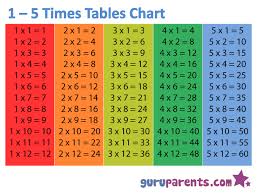
Skip-counting is probably the best math skill for memorizing multiplication tables without simply repeating the numbers. They should do this slowly and carefully.Īfter this, instruct children to form pairs and try to recite the multiplication table to their partner, without looking at the paper. Once they finish writing the multiplication table, ask students to read it out loud both ways – forward and backward. Recite the Multiplication Table Forward and Backward

This is going to make them more involved and focused on the activity. The goal is for every child to write their own multiplication table with the colors they love the most. Let them copy the table on a drawing block using color pencils of their choosing. Instead of printing and dividing multiplication tables to each student, make one large poster, and ask students to write their own multiplication table. The activities explained below help children familiarize themselves with multiplication tables and feel comfortable when using them without the pressure of knowing them by heart, right from the start. Step 1: Familiarize Children With Multiplication Tables The easiest way to learn multiplication tables is by engaging in a range of activities that train children’s memory without them actively trying to memorize multiplication answers by simple repetition. When they have understood the concept of multiplication and are comfortable with using the multiplication table, give children specific memory tasks, instead of simply asking them to memorize the whole multiplication table. After this, slowly start introducing higher numbers and present the multiplication table as a handy tool through which kids can search for the answers. To avoid creating anxiety when telling children they should memorize the whole multiplication table, first learn multiplication as repeated addition with practical examples. Before learning multiplication tables, kids should be comfortable with skip counting solving addition and subtraction operations, so relate multiplication to addition. The best way for children to learn new concepts is if you associate them with something they already know. With multiplication, we can calculate how much money we need when we travel, or find out how much food we need to buy if 9 friends are coming to our birthday party.” Relate Multiplication to Addition Say something along the lines of: “If we want to be smart when we grow up and solve problems, we need to learn multiplication. If you do this right, you’ll motivate students to learn, which is imperative for the learning process. The first step is to explain to children “why” learning multiplication is important, not just how they should memorize the multiplication tables. However, you can still fight this stereotype by making math fun and relatable. Let’s face it, math has a bad rep because you can’t teach it through a captivating story or let children learn through their senses, which is the dominant way kids learn new things.

#Multiplication table easy way to learn how to#
How to Learn Multiplication Tables?īefore we take a look at some of the specific activities through which your student or child can train their memory and learn multiplication tables in a fun way, we should say a word or two on how to motivate children in learning multiplication.


In this article, we’ll show you how to explain the concept of multiplication in a simple way, and then break down three crucial steps that will help your students memorize multiplication tables fast. So, naturally, as a teacher, homeschool tutor, or even parent, you would like to know how to learn multiplication tables, so you can help your child or students make this cognitive leap as smoothly as possible. Since addition and subtraction are usually based on actual objects that children have observed in the environment, multiplication becomes the first arithmetical operation where children will deal with abstract number representations. This is the time where children must learn to calculate math problems in their head, using prior knowledge. It’s no secret that teaching math concepts can be a daunting task, especially when taking a leap from concrete and simple operations to more abstract math problems where finger or object counting is no longer possible.


 0 kommentar(er)
0 kommentar(er)
